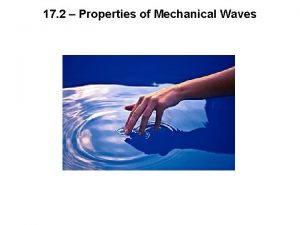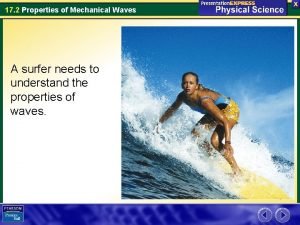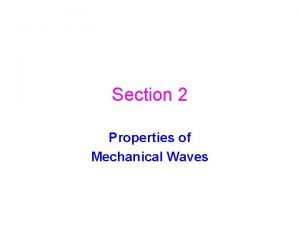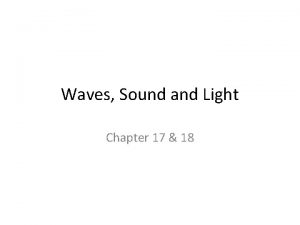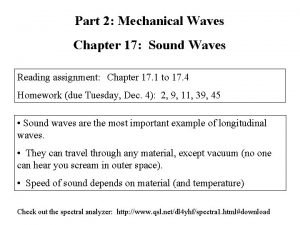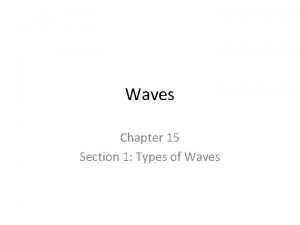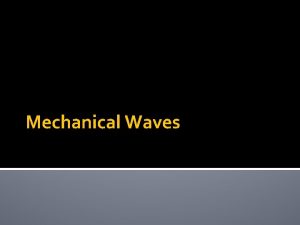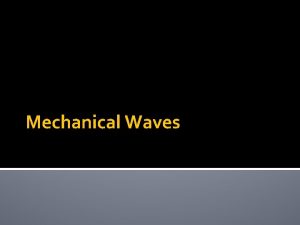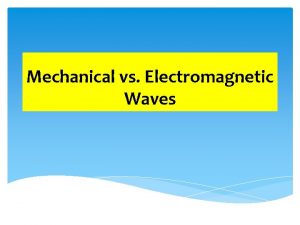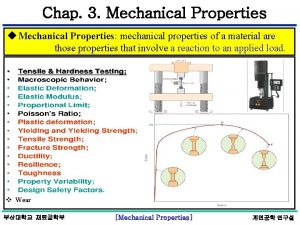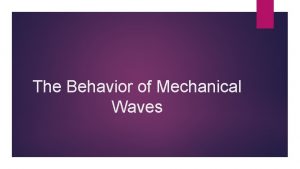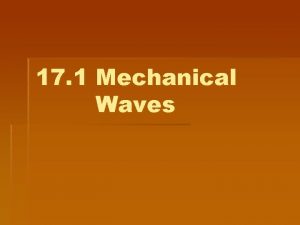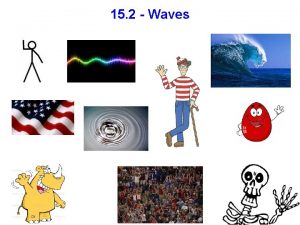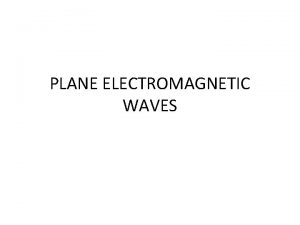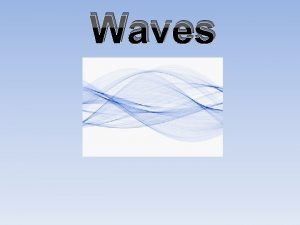Section 2 Properties of Mechanical Waves Key Concepts















- Slides: 15

Section 2 Properties of Mechanical Waves

Key Concepts • What determines the frequency of a wave? • How are frequency, wavelength, and speed related? • How is the amplitude of a wave related to the wave’s energy?

There are many different kinds of Waves • All waves have amplitude, wavelength, and frequency

Site Frequency and Period • Any motion that repeats at regular time intervals is called periodic motion. • The time required for one cycle, a complete motion that returns to its starting point, is called the period. • Any periodic motion has a frequency, which is the number of complete cycles in a given time. • Frequency is measured in cycles per second, or hertz (Hz). • A wave’s frequency equals the frequency of the vibrating source producing the wave.

Frequency and Period Frequency = 1. 0 hertz Frequency = 2. 0 hertz One cycle per second Two cycles per second Rest position

Wavelength • the distance between a point on one wave and the same point on the next cycle of the wave.

Wavelength • Actually wavelength can be measured from any point on the wave as long as it is measured to the same point on the next wave

Frequency and Wavelength • Increasing the frequency of a wave decreases its wavelength.

Wave Speed • Formula: • Speed = Wavelength x Frequency • The speed of a wave can change if it enters a new medium or if variables such as pressure and temperature change. • If you assume that waves are traveling at a constant speed, then wavelength is inversely proportional to frequency

• A wave on a rope has a wavelength of 2. 0 m and a frequency of 2. 0 Hz. What is the speed of the wave?

• A motorboat is tied to a dock with its motor running. The spinning propeller makes a surface wave in the water with a frequency of 4 Hz and a wavelength of 0. 1 m. What is the speed of the wave?

• What is the wavelength of an earthquake wave if it has a speed of 5 km/s and a frequency of 10 Hz?

Amplitude • of a wave is the maximum displacement of the medium from its rest position. • Amplitude represents the amount of energy in a wave • The more energy a wave has, the greater is its amplitude.

Amplitude • As energy increases, particles of the medium are moved a greater distance from the rest position • Can be positive or negative

Reviewing Concepts • 1. How is the vibration of the source related to a wave’s frequency? • 2. How is wavelength related to frequency for waves moving at a constant speed? • 3. How is the energy of a wave related to its amplitude? • 4. Describe two ways you could measure the wavelength of a longitudinal wave. • 5. Describe how you measure the amplitude of a transverse wave.
 Low amplitude wave
Low amplitude wave An example for mechanical wave
An example for mechanical wave Difference between electromagnetic waves and sound waves
Difference between electromagnetic waves and sound waves Mechanical waves and electromagnetic waves similarities
Mechanical waves and electromagnetic waves similarities Mechanical vs electromagnetic waves
Mechanical vs electromagnetic waves Similarities of mechanical and electromagnetic waves
Similarities of mechanical and electromagnetic waves Is a seismic wave mechanical or electromagnetic
Is a seismic wave mechanical or electromagnetic Mechanical waves and electromagnetic waves venn diagram
Mechanical waves and electromagnetic waves venn diagram Electromagnetic waves are longitudinal waves true or false
Electromagnetic waves are longitudinal waves true or false Properties of mechanical wave
Properties of mechanical wave Properties of mechanical waves
Properties of mechanical waves Properties of mechanical waves
Properties of mechanical waves Different types of mechanical waves
Different types of mechanical waves Chapter 17 mechanical waves and sound wordwise answer key
Chapter 17 mechanical waves and sound wordwise answer key How do matter and energy interact when waves are generated
How do matter and energy interact when waves are generated Chapter 15 section 1 types of waves answers
Chapter 15 section 1 types of waves answers









